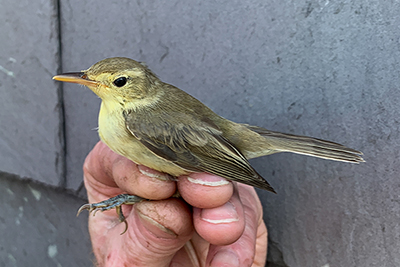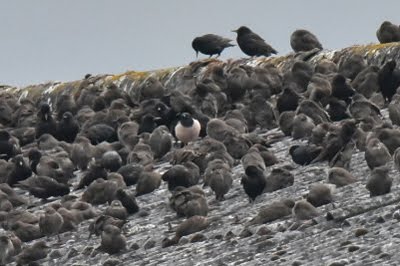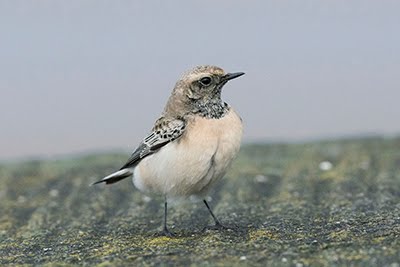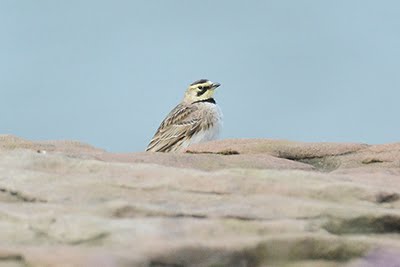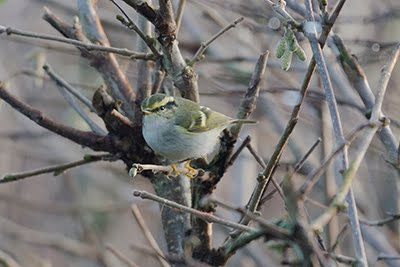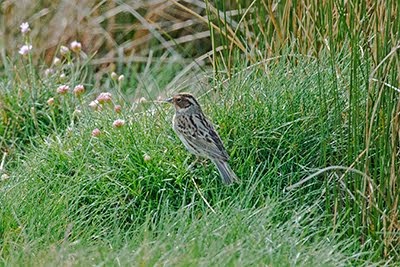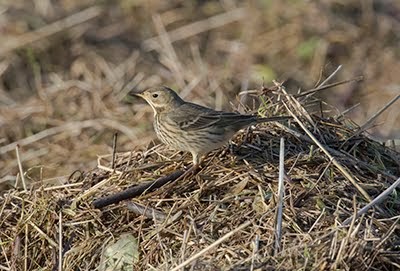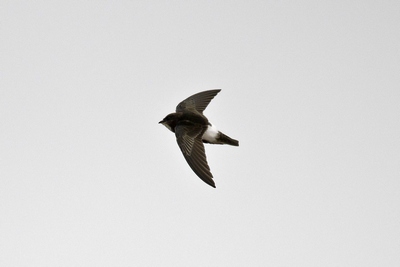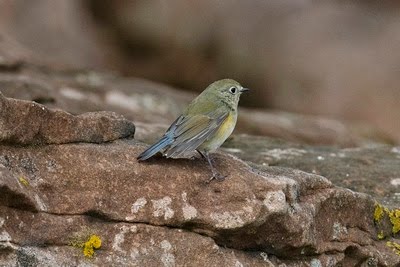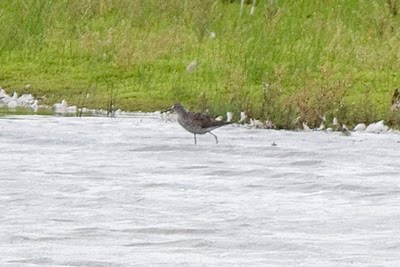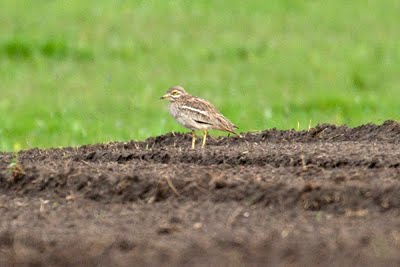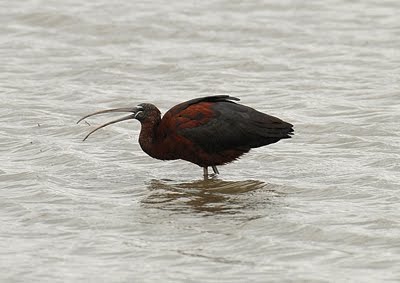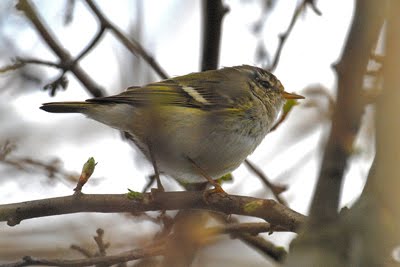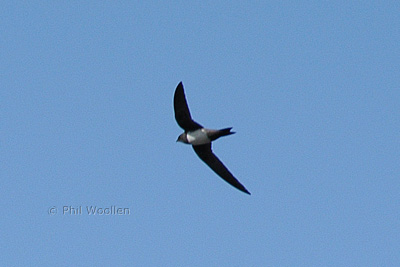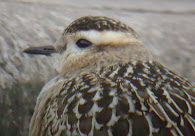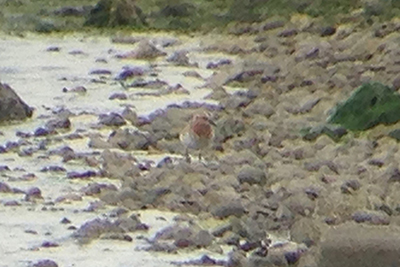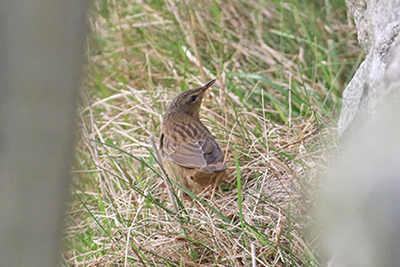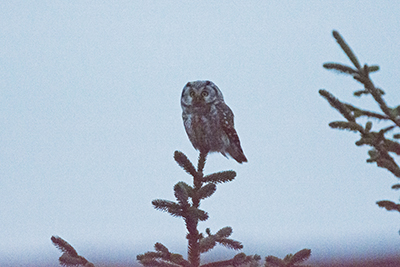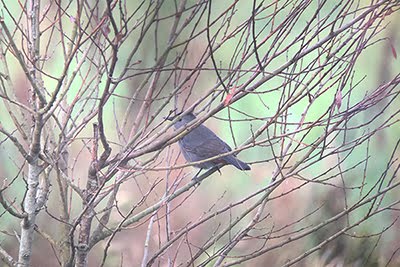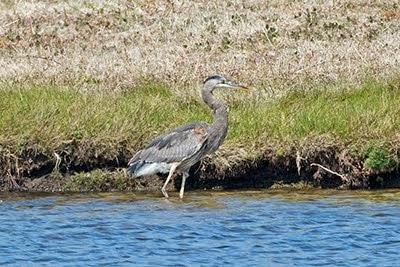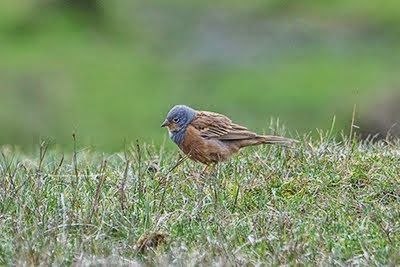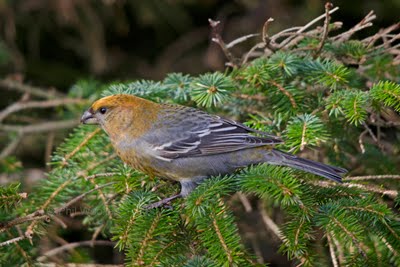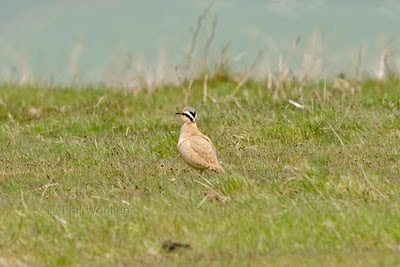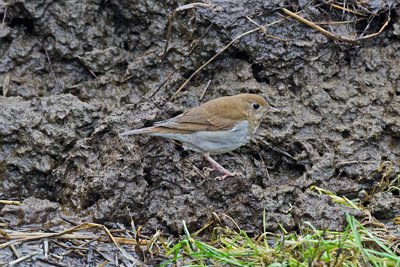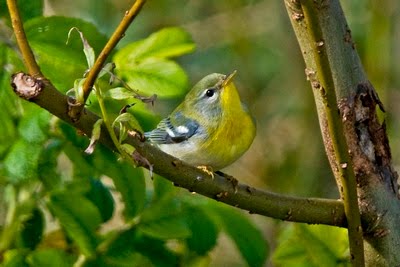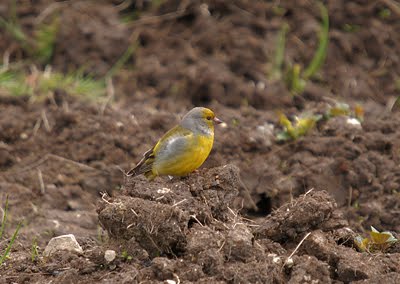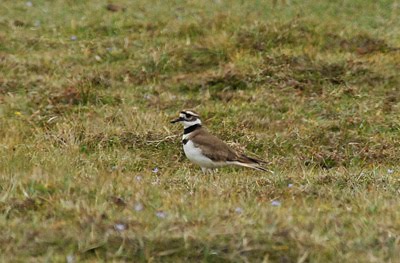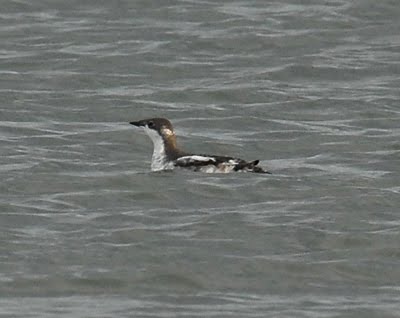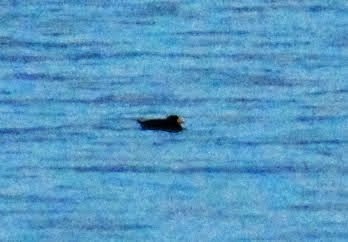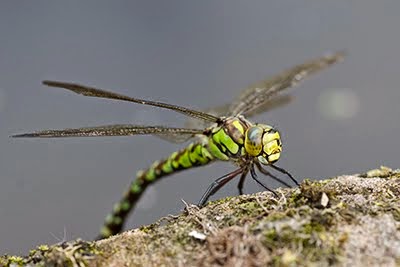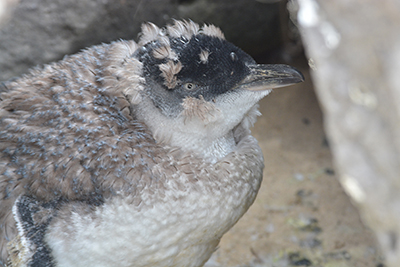With wader numbers building up on the Dee Estuary I picked up Steve for a couple of hours sifting through the birds as they moved closer to the prom as the tide flooded. Its a fantastic spectacle with Dunlin, Knot, Grey Plover, Ringed Plover, Oystercatchers, Bar-tailed Godwits, Curlew and Whimbrel all being recorded in various numbers.
We'd hoped for something unusual like a Little Stint or Curlew Sandpiper or even rarer American peep. The Stint eluded us but we did find this cracking juvenile Curlew Sandpiper just down from the Lifeboat station.
Scanning through the Oystercatcher flock looking for any of the colour ringed birds we'd ringed in N Wales last winter I came across this bird. First indications are it may have been ringed at Dawlish Warren in Devon!
31 Aug 2014
27 Aug 2014
More from Hilbre & a few hours in the garden.
Waking up to an unusual noise outside at first light my mind was still in sleep mode and it took me a few seconds to register that the raucous noise outside our window was in fact a Rose-ringed Parakeet! It was in the trees adjacent to the garden and was there for about 10 minutes before flying off. A nice surprise during what has been a generally quiet August locally.
I spent most of the weekend inside painting but managed a few hours ringing in the garden Sunday afternoon. This was very successful with 20 new birds being ringed and the majority were finches with 7 Goldfinches and three Greenfinches being ringed. Only one re-trap was caught - an adult male Goldfinch I first caught in October 2012. This was the only adult. All the others were juveniles in various states of post juvenile moult. Some were in completely juvenile plumage and some, like the one below, were just moulting their heads to attain the adults red crown feathers.
The juvenile bird below has still got all its buff-tipped juvenile greater coverts whereas some had already moulted the majority leaving just the outer ones recognisable as juvenile.
One of the Greenfinches was interesting. Its known that a small percentage of this species do moult some of their primaries during the post juvenile moult but this is the first time I've come across one with such an extensive moult of greater and primary coverts and the inner primaries!
More typical was the adult male undergoing its full post breeding moult.
This bird had also been making good use of the plentiful supply of Blackberries and Elderberries locally and was probably attracted to the sunflower hearts for a bit of variety.
Star of the day however was this adult male Nuthatch that had almost completed its post breeding moult and looked stunning in the late afternoon sunshine. Note the paint on the ringers fingers!
Garage ringing station:
With an easterly bias to the wind forecast Bank Holiday Monday plans were made to meet up with Steve and venture out to Hilbre. Unfortunately heavy overnight rain put paid to much migration but there was a small passage of Robins with 5 new birds on the island of which 3 were caught and ringed. With the island very quiet and not much happening seabird wise we left just before high tide at 10 am which gave me an opportunity to walk around my local fields. Nothing! The best bird was a single Yellowhammer. I couldn't even find a Blackcap or Whitethroat feeding up on the blackberries. I did find this caterpillar though which was later identified as a Buff-tip moth caterpillar.
The adults (this is one I caught in the garden whilst moth trapping a few years ago) resemble a dead birch twig - or a cigarette butt!
I spent most of the weekend inside painting but managed a few hours ringing in the garden Sunday afternoon. This was very successful with 20 new birds being ringed and the majority were finches with 7 Goldfinches and three Greenfinches being ringed. Only one re-trap was caught - an adult male Goldfinch I first caught in October 2012. This was the only adult. All the others were juveniles in various states of post juvenile moult. Some were in completely juvenile plumage and some, like the one below, were just moulting their heads to attain the adults red crown feathers.
The juvenile bird below has still got all its buff-tipped juvenile greater coverts whereas some had already moulted the majority leaving just the outer ones recognisable as juvenile.
One of the Greenfinches was interesting. Its known that a small percentage of this species do moult some of their primaries during the post juvenile moult but this is the first time I've come across one with such an extensive moult of greater and primary coverts and the inner primaries!
More typical was the adult male undergoing its full post breeding moult.
This bird had also been making good use of the plentiful supply of Blackberries and Elderberries locally and was probably attracted to the sunflower hearts for a bit of variety.
Star of the day however was this adult male Nuthatch that had almost completed its post breeding moult and looked stunning in the late afternoon sunshine. Note the paint on the ringers fingers!
Garage ringing station:
With an easterly bias to the wind forecast Bank Holiday Monday plans were made to meet up with Steve and venture out to Hilbre. Unfortunately heavy overnight rain put paid to much migration but there was a small passage of Robins with 5 new birds on the island of which 3 were caught and ringed. With the island very quiet and not much happening seabird wise we left just before high tide at 10 am which gave me an opportunity to walk around my local fields. Nothing! The best bird was a single Yellowhammer. I couldn't even find a Blackcap or Whitethroat feeding up on the blackberries. I did find this caterpillar though which was later identified as a Buff-tip moth caterpillar.
The adults (this is one I caught in the garden whilst moth trapping a few years ago) resemble a dead birch twig - or a cigarette butt!
21 Aug 2014
Essential maintenance and a Yellow-legged Gull.
Another trip to Hilbre this week to help Chris carry out essential repairs to the seawatching hide that had been badly knocked about during last Novembers storm surge. The surge knocked down a brick wall protecting the west side of the hide then burst through the west side observation flap. As it had no where to go it pushed the front of the hide out of line and broke the hinges of the forward facing observation flaps. Its now all ready for the autumn season.
There wasn't much to see on the sea with three juvenile Shags being about the only birds out there! Highlight was me finding an adult Yellow-legged Gull roosting on the beach, with the Lesser Black-backed and Herring Gulls as I drove on following the tide as it receded.
Ringing was restricted to a single Robin and an island bred juvenile Dunnock.
There wasn't much to see on the sea with three juvenile Shags being about the only birds out there! Highlight was me finding an adult Yellow-legged Gull roosting on the beach, with the Lesser Black-backed and Herring Gulls as I drove on following the tide as it receded.
Ringing was restricted to a single Robin and an island bred juvenile Dunnock.
16 Aug 2014
A late summers afternoon on Hilbre
Its been a few weeks since I was last on Hilbre and the fine weather Friday afternoon spurred me on to get over and joint the Chairman and family for a few hours spent lazing around on the island over the tide.
What a good decision! Not only was the weather good but we caught a few birds as well! Highlights were a Pied Wagtail (a new ringing species for me!), a moulting Redstart and a REED WARBLER! A huge rarity on Hilbre but common everywhere else. IN the 60 year history of the Obs there have only been 8 records and I'd never see none on the island before. Having seen the mega rare Blyth's Reed Warbler on Hilbre I was a bit shocked to see it fly in front of me as I entered one of the heligoland traps and once back at the Obs we double checked the wing formula to make sure it wasn't the rarer species.
Permission was also sought and granted to ring the 2nd brood of Swallows in the look out station and the Chairman duly ringed a brood of 3 young birds.
Wader numbers are building up and large numbers of Ringed Plover and Dunlin spent the high tide at the south end.
Eat your heart out Daniel Craig. You never looked this cool stepping out the sea in your trunks.
Many of the Dunlin are still in summer plumage with black bellies whilst the number of juveniles suggest they've had a good breeding season.
A young Peregrine had a half-hearted attempt at trying to catch one of the roosting waders by flushing them off the rocks but they were wise to the trick and kept low over the water before returning to their ledges.
We also had time to practice our amphibious landing maneuvers in readiness for the big autumn rarity. With the Chairman at the helm I took the opportunity to take a look at the Island form the sea - a view I'd not seen before.
A fabulous afternoon with a good variety of birds caught and seen Little Tern numbers are building up and as we drove off after the tide the gutter was full of them diving for fish.
What a good decision! Not only was the weather good but we caught a few birds as well! Highlights were a Pied Wagtail (a new ringing species for me!), a moulting Redstart and a REED WARBLER! A huge rarity on Hilbre but common everywhere else. IN the 60 year history of the Obs there have only been 8 records and I'd never see none on the island before. Having seen the mega rare Blyth's Reed Warbler on Hilbre I was a bit shocked to see it fly in front of me as I entered one of the heligoland traps and once back at the Obs we double checked the wing formula to make sure it wasn't the rarer species.
Permission was also sought and granted to ring the 2nd brood of Swallows in the look out station and the Chairman duly ringed a brood of 3 young birds.
Wader numbers are building up and large numbers of Ringed Plover and Dunlin spent the high tide at the south end.
We also had time to practice our amphibious landing maneuvers in readiness for the big autumn rarity. With the Chairman at the helm I took the opportunity to take a look at the Island form the sea - a view I'd not seen before.
A fabulous afternoon with a good variety of birds caught and seen Little Tern numbers are building up and as we drove off after the tide the gutter was full of them diving for fish.
11 Aug 2014
Bertha
Fresh back from a few days with my family in Somerset I decided to spend a few hours ringing in the garden after a leisurely start to the day! Unfortunately the remnants of Hurricane Bertha meant we had torrential rain and strong winds at times but there were patches of good weather that enable me to set a couple of mist nets.
Not many birds were caught but some interesting ones - a new juvenile Blackbird and only the 3rd Nutchatch I've ringed in the garden. Another unringed bird was also visiting the bird feeders later in the day.
The young Blue & Great Tits are making great inroads into my supplies of sunflower hearts and all have a healthy fat score with the furcular pits bulging.
The occasional juvenile bird, like this Great Tit was caught with fault barring on the tail suggesting a period of food stress during the nest stage. These feathers will probably be replaced during the post juvenile moult as Great Tits do moult their tails during this moult. if not it'll be during the post breeding moult next year and by then will be pretty battered and worn as the fault bars are a weak spot. it is possible that the bird may accidentally lose its tail and grow a replacement before the annual moult.
It appears that our local Goldfinches have successfully reared a 2nd brood as the adults are returning with more juveniles in tow.
The observant will note that the above photo is one I took a month or so ago before losing a finger nail on my right hand as seen in the other photo's! That was the result of banging my finger instead of a nail whilst repairing one of the heligoland traps on Hilbre.
Not many birds were caught but some interesting ones - a new juvenile Blackbird and only the 3rd Nutchatch I've ringed in the garden. Another unringed bird was also visiting the bird feeders later in the day.
The young Blue & Great Tits are making great inroads into my supplies of sunflower hearts and all have a healthy fat score with the furcular pits bulging.
The occasional juvenile bird, like this Great Tit was caught with fault barring on the tail suggesting a period of food stress during the nest stage. These feathers will probably be replaced during the post juvenile moult as Great Tits do moult their tails during this moult. if not it'll be during the post breeding moult next year and by then will be pretty battered and worn as the fault bars are a weak spot. it is possible that the bird may accidentally lose its tail and grow a replacement before the annual moult.
It appears that our local Goldfinches have successfully reared a 2nd brood as the adults are returning with more juveniles in tow.
The observant will note that the above photo is one I took a month or so ago before losing a finger nail on my right hand as seen in the other photo's! That was the result of banging my finger instead of a nail whilst repairing one of the heligoland traps on Hilbre.
4 Aug 2014
Back home
We've just had a week on Lanzarote - a family holiday not a birding trip but I managed a few bits and bobs as well as a couple of dives where we saw a large school of Barracuda and a diving tick for me in the form of a large Stingray! I've spent quite a bit of time on the Canaries over the years and have caught up with all the specialties and endemics so was chilled about spending to much time birding.
A delayed flight coupled with a security scare at Aricife airport meant we didn't get home until 5.30 am this morning! By the looks of it autumn migration has begun.....
A delayed flight coupled with a security scare at Aricife airport meant we didn't get home until 5.30 am this morning! By the looks of it autumn migration has begun.....
Subscribe to:
Posts
(
Atom
)

















































